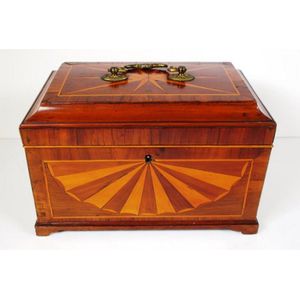Satinwood Tea Caddy with Secret Compartment
You must be a subscriber, and be logged in to view price and dealer details.
Subscribe Now to view actual auction price for this item
When you subscribe, you have the option of setting the currency in which to display prices to $Au, $US, $NZ or Stg.
- Satinwood - Satinwood is a dense pale gold coloured timber that was imported into Britain in the second half of the 18th century, and early 19th centuries from the East Indies and the West Indies. The name derives from the satin-like surface sheen when the timber is polished.
It was used in the solid, as a veneer and in inlays. As well as furniture, satinwood was used for making musical instruments, barometers, boxes and clocks.
It will usually be found on only the very best quality objects, presumably because of of its cost at the time. - George Iii - George III (1738 - 1820) was King of Great Britain and Ireland from 1760 to 1820.
- Oak - Native to Europe and England, oak has been used for joinery, furniture and building since the beginning of the medieval civilisation. It is a pale yellow in colour when freshly cut and darkens with age to a mid brown colour.
Oak as a furniture timber was superceded by walnut in the 17th century, and in the 18th century by mahogany,
Semi-fossilised bog oak is black in colour, and is found in peat bogs where the trees have fallen and been preserved from decay by the bog. It is used for jewellery and small carved trinkets.
Pollard oak is taken from an oak that has been regularly pollarded, that is the upper branches have been removed at the top of the trunk, result that new branches would appear, and over time the top would become ball-like. . When harvested and sawn, the timber displays a continuous surface of knotty circles. The timber was scarce and expensive and was used in more expensive pieces of furniture in the Regency and Victorian periods.
This item has been included into following indexes:
-
tea caddies, material
- pollard oak 16
- satinwood 39
- tea caddies, period or age - Georgian 320
Visually similar items

An Arabian style studded teak blanket chest, early to mid 20th century, decorated in Eastern style studded geometric designs to top and front panel chest interior has a candle box to one side; lower underneath is a secret hidden compartment chamber. Height

A Regency period, rosewood and brass inlay sarcophagus shape, tea caddy, c.1820-1830, with two pullout canister boxes and central cut crystal mixing bowl. Height 19.2 cm. Length 30 cm. Depth 16 cm

Three sarcophagus shaped tea caddies, 19th century, each of varying size, two raised on bun feet with ring handle details, the other with Tunbridge inlay, 20 cm, 16.5 cm and 13.5 cm respectively

Antique French Renaissance style carved oak lift top coffer, fitted with large strap work hinges and iron carry handles to the sides
